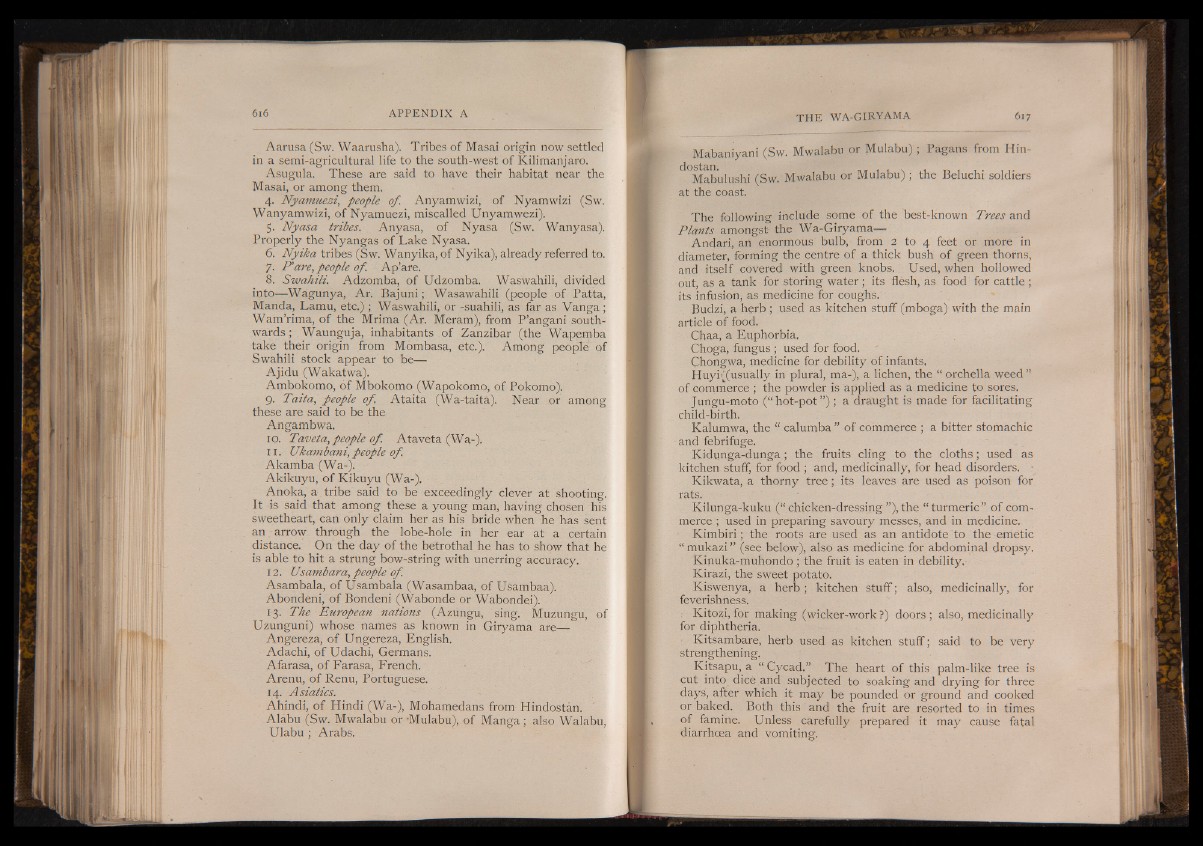
Aarusa (Sw. Waarusha). Tribes of Masai origin now settled
in a semi-agricultural life to the south-west of Kilimanjaro.
Asugula. These are said to have their habitat near the
Masai, or among them.
4. Nyamtiezi, people of. Anyamwizi, of Nyamwizi (Sw.
Wanyamwizi, of Nyamuezi, miscalled Unyamwezi).
5. Nyasa tribes. Anyasa, of Nyasa (Sw. Wanyasa),
Properly the Nyangas of Lake Nyasa.
6. Nyika tribes (Sw. Wanyika, of Nyika), already referred to.
7. P'are, people of. Ap’are.
8. Swahili. Adzomba, of Udzomba. Waswahili, divided
into— Wagunya, Ar. Bajuni; Wasawahili (people of Patta,
Manda, Lamu, etc.) ; Waswahili, or -suahili, as far as Vanga ;
Wam’rima, of the Mrima (Ar. Meram), from P’angani southwards
; Waunguja, inhabitants of Zanzibar (the Wapemba
take their origin from Mombasa, etc.). Among people of
Swahili stock appear to be—
Ajidu (Wakatwa).
Ambokomo, of Mbokomo (Wapokomo, of Pokomó).
9. Taita, people of. Ataita (Wa-taita). Near or among
these are said to be the
Angambwa.
10. Taveta, people of. Ataveta (Wa-).
11. XJkambani, people of.
Akamba (Wa-).
Akikuyu, of Kikuyu (Wa-).
Anoka, a tribe said to be exceedingly clever at shooting.
It is said that among these a young man, having chosen his
sweetheart, can only claim her as his bride when he has sent
an arrow through the lobe-hole in her ear at a certain
distance. On the day of the betrothal he has to show that he
is able to hit a strung bow-string with unerring accuracy.
12. Usambara, people of.
Asambala, of Usambala (Wasambaa, of Usambaa).
Abondeni, of Bondeni (Wabonde or Wabondei).
13. The European nations (Azungu, sing. Muzungu, of
Uzunguni) whose names as known in Giryama are—
Angereza, of Ungereza, English.
Adachi, of Udachi, Germans.
Afarasa, of Farasa, French.
Arenu, of Renu, Portuguese.
14. Asiatics.
Ahindi, of Hindi (Wa-), Mohamedans from Hindostán.
Alabu (Sw. Mwalabu or -Mulabu), of Manga I also Walabu,
Ulabu ; Arabs.
Mabaniyani (Sw. Mwalabu or Mulabu); Pagans from Hindostán.
T,T 1 L N t Til
Mabulushi (Sw. Mwalabu or Mulabu); the Beluchi soldiers
at the coast.
The following include some of the best-known Trees and
Plants amongst the Wa-Giryama—
Andari, an enormous bulb, from 2 to 4 feet or more in
diameter, forming the centre of a thick bush of green thorns,
and itself covered with green knobs. Used, when hollowed
out, as a tank for storing water; its flesh, as food for cattle ;
its infusion, as medicine for coughs.
Budzi, a herb ; used as kitchen stuff (mboga) with the main
article of food.
Chaa, a Euphorbia,
Choga, fungus ; used for food.
Chongwa, medicine for debility of infants,
Huyi ((usually in plural, ma-), a lichen, the “ orchella weed"
of commerce ; the powder is applied as a medicine to sores.
Jungu-moto (“ hot-pot”) ; a draught is made for facilitating
child-birth.
Kalumwa, the “ calumba ” of commerce ; a bitter stomachic
and febrifuge.
Kidunga-dunga; the fruits cling to the cloths; used as
kitchen stuff, for food ; and, medicinally, for head disorders.
Kikwata, a thorny tree; its leaves are used as poison for
rats.
Kilunga-kuku (“ chicken-dressing ”), the “ turmeric” of commerce
; used in preparing savoury messes, and in medicine.
Kimbiri; the roots are used as an antidote to the emetic
“ mukazi ” (see below), also as medicine for abdominal dropsy,
Kinuka-muhondo; the fruit is eaten in debility.
Kirazi, the sweet potato.
Kiswenya, a herb; kitchen stuff; also, medicinally, for
feverishness.
, Kitozi, for making (wicker-work ?) doors ; also, medicinally
for diphtheria.
Kitsambare, herb used as kitchen stuff; said to be very
strengthening.
Kitsapu, a “ Cycad.” The heart of this palm-like tree is
cut into dice and subjected to soaking and drying for three
days, after which it may be pounded or ground and cooked
or baked. Both this and the fruit are resorted to in times
of famine. Unless carefully prepared it may cause fatal
diarrhoea and vomitingQ.